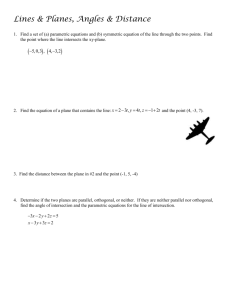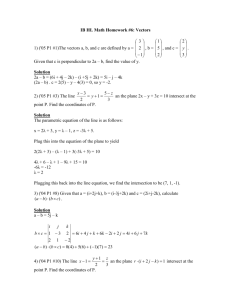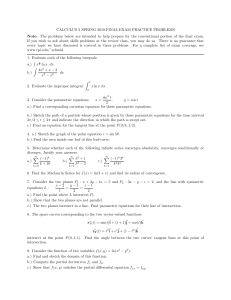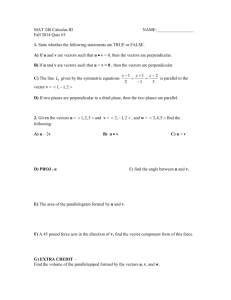Vector Exercise
advertisement
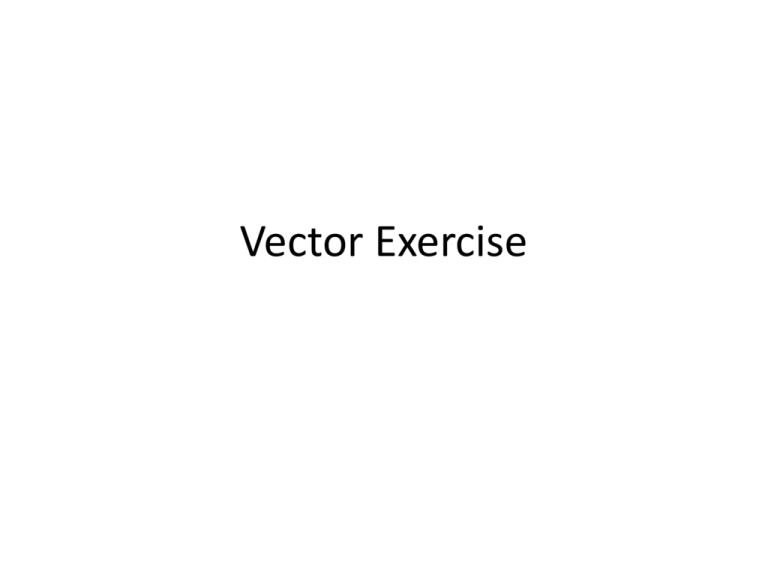
Vector Exercise
Parametric form for a line
• Passing two points
Point Normal Form for a Line
• N.(P-C)=0
Finding the Intersection of Two Lines
• Given two line segments, determine whether
they intersect, and if they do, find their point
of intersection
Intersection of Lines with Planes
• Useful in clipping
• Ray in parametric form
• Plane in point normal form
Representing Lines and Planes
The parametric representation of a
line
• This is done using a parameter t that distinguishes one point
on the line from another. Call the line L, and give the name L(t)
to the position associated with t. Using b = B - A we have:
– L(t) = A + b t
|t| is the ratio of the distances
|L(t) - A| to |B - A|,
Exercise
• Example 4.5.2. A line in 2D. Find a parametric form for the
line that passes through C= (3, 5) and B = (2,7).
– Solution: Build vector b = B - C = (-1, 2) to obtain the parametric form
L(t) = (3 - t, 5 + 2 t).
• Example 4.5.3. A line in 3D. Find a parametric form for the
line that passes through C= (3, 5,6) and B = (2,7,3).
– Solution: Build vector b = B - C = (-1, 2, -3) to obtain the parametric
form L(t) = (3 - t, 5+ 2 t, 6 - 3t).
Point normal form for a line (the
implicit form)
• fx+gy=1
Exercise
• Example 4.5.4. Find the point normal form.
• Suppose line L passes through points C = (3, 4) and B = (5, -2).
Then b = B - C = (2, -6) and b ‘s normal = (6, 2) Choosing C as
the point on the line, the point normal form is: (6, 2) . ((x, y) (3, 4)) = 0, or 6x + 2y = 26. Both sides of the equation can be
divided by 26 (or any other nonzero number) if desired.
• f x + g y = 1. Writing this once again as (f, g) .(x, y) = 1 it is clear
that the normal n is simply (f, g) (or any multiple thereof). For
instance, the line given by 5x - 2y = 7 has normal vector (5, -2),
or more generally K(5, -2) for any nonzero K.
Moving from each representation to the others.
• The three representations and their data are:
– The two point form: say C and B; data = {C, B}
– The parametric form: C + bt; data = {C, b}.
– The point normal (implicit) form (in 2D only): n.(P
- C) = 0; data = {C, n}.
Planes in 3D space.
• Planes, like lines, have three fundamental
forms:
– the three-point form,
– the parametric representation and
– the point normal form.
The parametric representation of a
plane.
Example
Find a parametric form given three points in a plane.
Consider the plane passing through A = (3,3,3), B = (5,5,7), and
C = (1, 2, 4).
From Equation 4.43 it has parametric form
P(s, t) = (1, 2, 4) + (2, 1, - 1) s + (4, 3, 3) t.
This can be rearranged to the component form: P(s, t) = (1 + 2 s
+ 4 t) i + (2 + s + 3 t) j + (4 - s + 3 t) k,
or to the affine combination form P(s, t) = s(3, 3, 3) + t(5, 5, 7) +
(1 - s - t)(1,2, 4).
The point normal form for a plane.
Exercise
• Find a point normal form.
Let plane P pass through (1, 2, 3) with normal vector (2, -1, -2).
Its point normal form is (2, -1, -2) .((x, y, z) - (1, 2, 3)) = 0. The equation for the plane may
be written out as 2x - y - 2z = 6.
Exercise
• Find a parametric form given the equation of
the plane.
Find a parametric form for the
plane 2 x - y + 3 z = 8. Solution: By inspection the normal is (2, - 1, 3). There are
many parametrizations;
we need only find one. For C, choose any point that satisfies the equation; C = (4,
0, 0) will do. Find two
(noncollinear) vectors, each having a dot product of 0 with (2, - 1, 3); some
hunting finds that a = (1, 5, 1)
and b = (0, 3, 1) will work. Thus the plane has parametric form P(s, t) = (4, 0, 0) +
(1, 5, 1) s + (0, 3, 1) t.
Find two noncolinear vectors
• a = (0, 0, 1) x n
• b=nxa
Moving from each representation to the others.
• For a plane, the three representations and
their data are:
– The three point form: say C , B, and A; data = {C, B,
A}
– The parametric form: C + as + bt; data = {C, a, b}.
– The point normal (implicit) form: n.(P - C) = 0;
data = {C, n}.
Finding the Intersection of two
Line Segments.
•
•
•
•
AB(t) = A + b t
CD(u) = C + d u,
intersect: A + bt = C + du
Defining c = C - A for convenience we can
write this condition in terms of three known
vectors and two (unknown) parameter values:
• bt = c + du
Example
4.6.1: Given the endpoints A = (0, 6), B = (6, 1), C = (1, 3), and D = (5, 5), find the
intersection if
it exists. Solution: d ^ = (-2,4), so t = 7/16 and u = 13/32 which both lie between 0
and 1, and so the
segments do intersect. The intersection lies at (x, y) = (21/8, 61/16). This result
may be confirmed visually
by drawing the segments on graph paper and measuring the observed
intersection.
Parallel and overlap
Find the center of a circle
Intersection of lines with planes
•
•
•
•
Hit point
R(t) = A + ct
n.(p-B) =0
thit = n.(B-A)/n.c
Intersection of two planes
• One parametric form
• one point normal form
Convex polygon
• Connecting any two points lies completely
inside it

